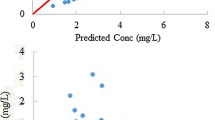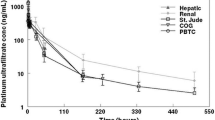Abstract
Gentamicin monitoring and the selection of the initial dosage are generally based on the relationship between pharmacokinetic parameters of gentamicin (GPP) and patient characteristics and/or clinical data (PC). However, the number of studies about this relationship in cancer patients is limited. Therefore, the main objective of the present study was to evaluate the relationship between GPP and PC in cancer patients and to identify different subgroups within this group of patients with unique relationship models between GPP and PC. A total of 198 cancer patients were included in the study. Firstly, GPP were estimated by the Sawchuk and Zaske regression method. Then, a linear regression analysis was performed to investigate the relationship between GPP and PC, and lastly subgroups with unique models were identified by comparing their regression models. The results revealed that the variable which was the best predictor of the distribution volume of gentamicine was the dosing weight (DW = IBW + (ABW‐IBW), ABW being the actual body weight and IBW the ideal body weight). Creatinine clearance (CLCR) measured by a 24‐hour urine collection (CLCRu) was the best predictor of gentamicin clearance (CL). When this value is not available, the CLCR estimated by the formula of Crockcroft and Gault (C‐G), can be used. When the C‐G formula was used, unique models to predict CL from CLCR were identified for patients who were obese, patients who had received high‐dose chemotherapy and, for subjects who had never developed aplasia following chemotherapy. Whichever the model used, the results showed that some variability in pharmacokinetic parameters of gentamicin was not explained by the models, especially in some groups of patients.
Similar content being viewed by others
References
Mandler HD, Dudley MN. Chapter 46: Immunocompromised host infections. In: Kode-Kimble MA, Young LY, eds. Applied Therapeutics. The clinical use of drugs. Fifth Ed. Applied Therapeutics Inc; 1992.
Zaske DE. Chapter 14: Aminoglycosides. In: Evans WE, Schentag EE and Jusko J, eds. Applied Pharmacokinetics. Principles of Therapeutic Drug Monitoring. Vancouver: Applied Therapeutics, Inc; 1992.
Noone P, Parsons TMC, Pattison JR, Slack RBC, Garfield-Davies D, Huges K. Experience in monitoring gentamicin therapy during treatment of serious gram-negative sepsis. BMJ 1974;1:477-81.
Moore RD, Lietman PS, Smith CR. Clinical response to aminoglycoside therapy: importance of the ratio of peak concentration to minimal inhibitory concentration. J Infect Dis 1987;155:93-9.
Dahlgren JG, Anderson ETT, Hewitt WL. Gentamicin blood levels: A guide to nephrotoxicity. Antimicrob Agts Chemother 1975;8:58-62.
Barza M, Brown RB, Shen D, Gibaldi M, Weinstein L. Predictability of blood levels of gentamicin in man. J Infect Dis 1975;132:165-74.
Zaske DE, Cipolle RJ, Strate RJ. Gentamicin dosage requirements: wide interpatient variation in 242 surgery patients with normal renal function. Surgery 1980;87:164-9.
Ordovas JP, Ronchera CL, Poveda N, Jimenez NV, Lopez R. Selection of optimal prophylactic amonoglycoside dosage in cancer patients: population pharmacokinetic approaches. J Clin Pharm Ther 1994;19:47-56.
Inciardi JF, Batra KK. Nonparametric approach to population pharmacokinetics in oncology patients receiving aminoglycoside therapy. Antimicrob Agts Chemother 1993;37:1025-7.
Davis RL, Lehman D, Stidley CA, Neidhart J. Amikacin pharmacokinetics in patients receiving high-dose cancer chemotherapy. Antimicrob Agts Chemother 1991;35:944-7.
Bertino JS, Booker LA, Franck P, Rybicki B. Gentamicin pharmacokinetics in patients with malignancies. Antimicrob Agts Chemother 1991;35:1501-3.
Sawchuk RJ, Zaske DE. Pharmacokinetics of dosing regimens which utilize multiple intravenous infusions: gentamicin in burn patients. J Pharmacokinet Biopharm 1976;4:183-95.
Ortega A, Aldaz A, Giráldez J, Brugarolas A. Population pharmacokinetic parameters of gentamicin in solid tumour patients. Estimation by one and two stage methods. Ther Drug Monit 1998;20:184-90.
Miller AB, FRCP(C), Hougstraten B, Staquet M, Winkler A. Reporting results of cancer treatment. Cancer 1981;47:207-14.
Devine BJ. Gentamicin therapy. Drug Intell Clin Pharm 1974;8:650-5.
Morgan DJ, Bray KM. Lean Body Mass as a predictor of drug dosage. Implications for drug therapy. Clin Pharmacokinet 1994;26:92-307.
Burton ME, Chow MSS, Platt DR, Day RB, Brater DC, Vasko MR. Accuracy of Bayesian and Sawchuk-Zaske dosing methods for gentamicin. Clin Pharm 1986;5:143-9.
Chrystyn H. Validation of the use of bayesian analysis in the optimization of gentamicin therapy from the commencement of dosing. Drug Intell Clin Pharm 1988;22:49-53.
Mann MJ, Fuhs DW, Awang R, Ndemo FA, Cerra FB. Altered aminoglycoside pharmacokinetics in critically ill patients with sepsis. Clin Pharm 1987;6:148-53.
Crockcroft DW, Gault MH. Prediction of creatinine clearance from serum creatinine. Nephron 1976;16:31-4.
Jelliffe RW, Jelliffe SM. A computer program for estimation of creatinine clearance from unstable serum creatinine levels, age, sex and weight. Math Biosci 1972;14:17-24.
Feinstein AR. Multivariable Analysis. New Haven and London. Yale University Press, 1996.
Oparaoji EC, Cornwell EE, Hekmat E, Cheong RL, Addir JJS, Siram S. Aminoglycoside volume of distribution in postoperative patients with septic shock. Clin Pharm 1993;12:131-4.
Robert S, Zarowitz BJ. Is there a reliable index of glomerular filtration rate in critically ill patients? DICP Ann Pharmacother 1991;25:169-78.
Hull JH, Hark LJ, Koch GG, Wargin WA, Chi SL, Mattocks AM. Influence of range of renal function and liver disease on predictability of creatinine clearance. Clin Pharmacol Ther 1981;29(4):516-21.
Lott RS, Hayton WL. Estimation of creatinine clearance from serum creatinine concentration-a review. Drug Intell Clin Pharm 1978;12:140-50.
Lau AH, Bek SI, Posser T, Stonich T. Estimation of creatinine clearance in malnourished patients. Clin Pharm 1991;10:706-10.
Cochetto DM, Tschanz Ch, Bjornsson TD. Decreased rate of creatinine production in patients with hepatic disease: Implications for estimation of creatinine clearance. Ther Drug Monit 1983;5:161-68.
Echizen H, Ishizaki T. Superiority of disease-specific over conventional formula in predicing creatinine clearance from serum creatinine in patients with liver cirrhosis. Ther Drug Monit 1988;10:369-75.
Bjornsson TD. Use of serum creatinine concentrations to determine renal function. Clin Pharmacokinet 1979;4:200-22.
Zarowitz BJ, Robert S, Peterson EL. Prediction of glomerular filtration rate using aminoglycoside clearance in critically ill medical patients. Ann Pharmacother 1992;26:1205-10.
Welch LP, Leader WG, Chandler MHH. Predicting vancomycin pharmacokinetics by using aminoglycosides pharmacokinetics. Clin Pharm 1993;12:909-13.
Tsubaki T, Goodin S, Leader WG, Chandler MHH. Estimation of creatinine clearance in patients with gynecologic cancer. Clin Pharm 1993;12:685-90.
Jelliffe RW, Schumitzky A, Van Guilder M. USC*PACK collection of PC programs. Laboratory of Applied Pharmacokinetics. University of Southern California. School of Medicine. Los Angeles. California.
Miranda, Maldonado. Farmacocinética aplicada: aminoglicósidos. Revista de la O.F.I.L. 1993;3:397-407.
Matzke GR, Burkle WS, Lucarotti. Gentamicin and Tobramycin dosing guidelines. An evaluation. Drug Intell Clin Pharm 1983;17:425-32.
Philips JK, Spearing RL, Crome DJ, Davies JM. Gentamicin volumes of distribution in patients with hematologic disorders. N Engl J Med 1988;10:1290.
Rights and permissions
About this article
Cite this article
Ortega, A., Aldaz, A., Giráldez, J. et al. Relationship between pharmacokinetic parameters of gentamicin and patient characteristics and/or clinical data in patients with solid organ tumours. Pharm World Sci 21, 227–232 (1999). https://doi.org/10.1023/A:1008708119954
Issue Date:
DOI: https://doi.org/10.1023/A:1008708119954




